
6 minute read
My tryst with Tanjore paintings
from Vaak Issue 03 2021
Veeren Koneru
As a 19-year-old when I was in my 2nd year of medical school, my first acquisition of a Tanjavur painting happened quite by serendipity. In a dimly lit artefact store that sold kitschy handicrafts and curios, I came across a resplendent Tanjavur painting richly gilded with gold that shone like the sun. The painting was that of Krishna in Darbar.
Advertisement
He is delicately seated on a golden throne whose legs are in the shape of parrots. He is holding a golden pot of butter, and on either side of him are his parents, Nanda and Yashoda. On the right side, Yashoda is beautifully bedecked in plush jewellery with Mallipoo (jasmine) strands in her hair. A beautiful green parrot is perched on her left hand, and there is a blob of butter in her right hand. To his left, stands Nanda with a Vaishnava Thirunamam (white Y-shaped mark with a red midline) on his forehead and he is gingerly holding a pink rose in his left hand.
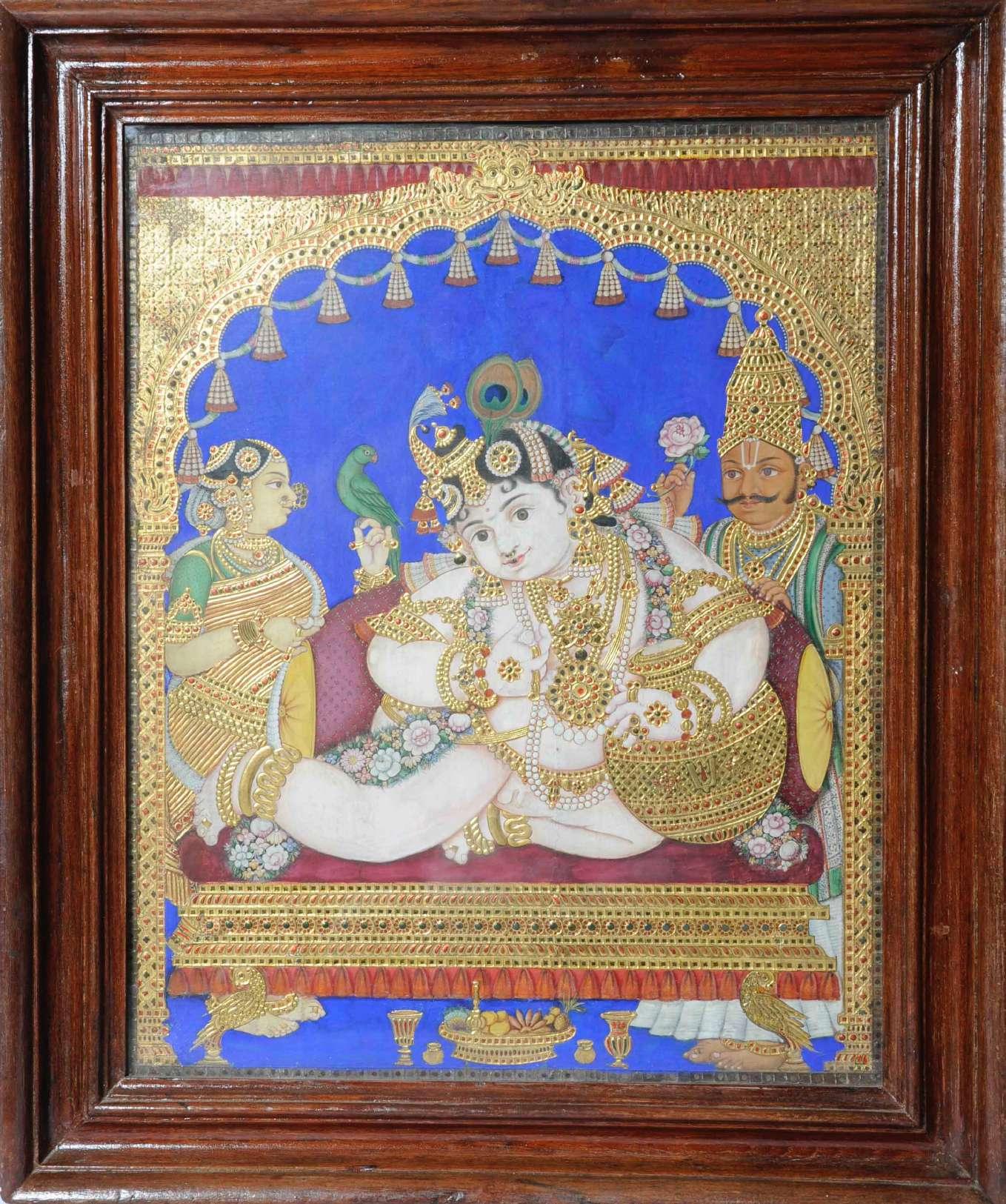
Veeren Koneru’s first Tanjore painting. This subject is popularly referred to as Vennaithali Krishnar
Krishna himself is in a pale pink skin tone. If you observe keenly, you can see that he is wearing the choicest of jewellery: on his neck, there is a Pulinagam (Tiger pendant), a Pathakam (pendant) strung with gold beads, and rows of Muthu Malai (Pearl strands); on his arms are gorgeous Vankis with Yazhi motifs on them; his wrists are adorned with a Makarakadagam among other bangles; on his ears hang Jhimkis with pearl drops, Kolusu are seen on his feet, and his hair is adorned with Thalai Saman like the Suryan, Chandran and an aigrette along with a peacock feather. The golden pot of butter that he is holding has the Thirunamam, Shankam and Chakram (conch shell and discus) on it. The attention to detail in this painting is stunning. Nanda’s moustache is done in true miniature style and is a marvel. The Mandapam that Krishna is seated under is rather simple. The painting, although done in low relief without encrusted stones, is typical of Tanjore paintings. It has traces of stones, and most of them had already been hastily plucked from the surface.
Krishna with his delicate features spoke to me that day. What followed was three sleepless nights. On the third day, I went to the store with a tiny fortune of cash tightly held in my pocket and brought the Krishna home. I stared at the painting for hours only to discover a new detail each time. I wondered who the artist was, for he never signed on this masterpiece. I still have no idea who the patron is, or who commissioned this painting, or in whose house this painting hung for more than four generations. Why would anyone want to part with this?
Tanjavur painting
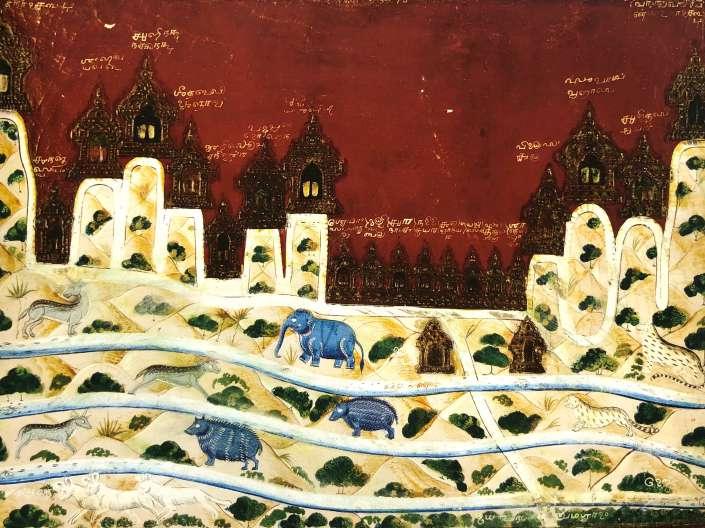
Shatrunjaya Hill (?), Tanjavur, 42.7 x 53.3 cm.
(Thanjavur’s Gilded Gods, 2018)
The Tanjavur region, abundantly blessed by the river Cauvery, patronised the arts. This region has given us rich art forms such as the Tanjavur paintings, the famous Tanjavur plate etc. Popularly known as Palagai Padam, these icons of worship are gilded in gold, richly decorated with embedded stones, and rendered on planks of wood. This art form was patronized by Serfoji XI, the Maratha king who ruled Tanjavur. The artists who made them are believed to be from the Telugu speaking Raju community who migrated from present day Andhra Pradesh. The wooden planks are seasoned and layered with paper or cloth (often newspapers), and the surface is decorated with gesso and gilded with gold foil. The rich use of foiled glass that mimicked precious stones is an important aspect of Tanjavur paintings. Hung in worship rooms, these icons were revered and passed on.
The paintings often have a central large figure under an ornate mandapam, with smaller figures on either side. The mandapams are decorated with blinds and garlands. Some paintings are decorated with glass chandeliers and lanterns indicating European influence. Winged angels are a quintessential presence in these paintings, and they are depicted as holding musical instruments or garlands. The themes vary from Vaishnavite and Saivite subjects to lesserknown Kula Deivams (local village Gods).
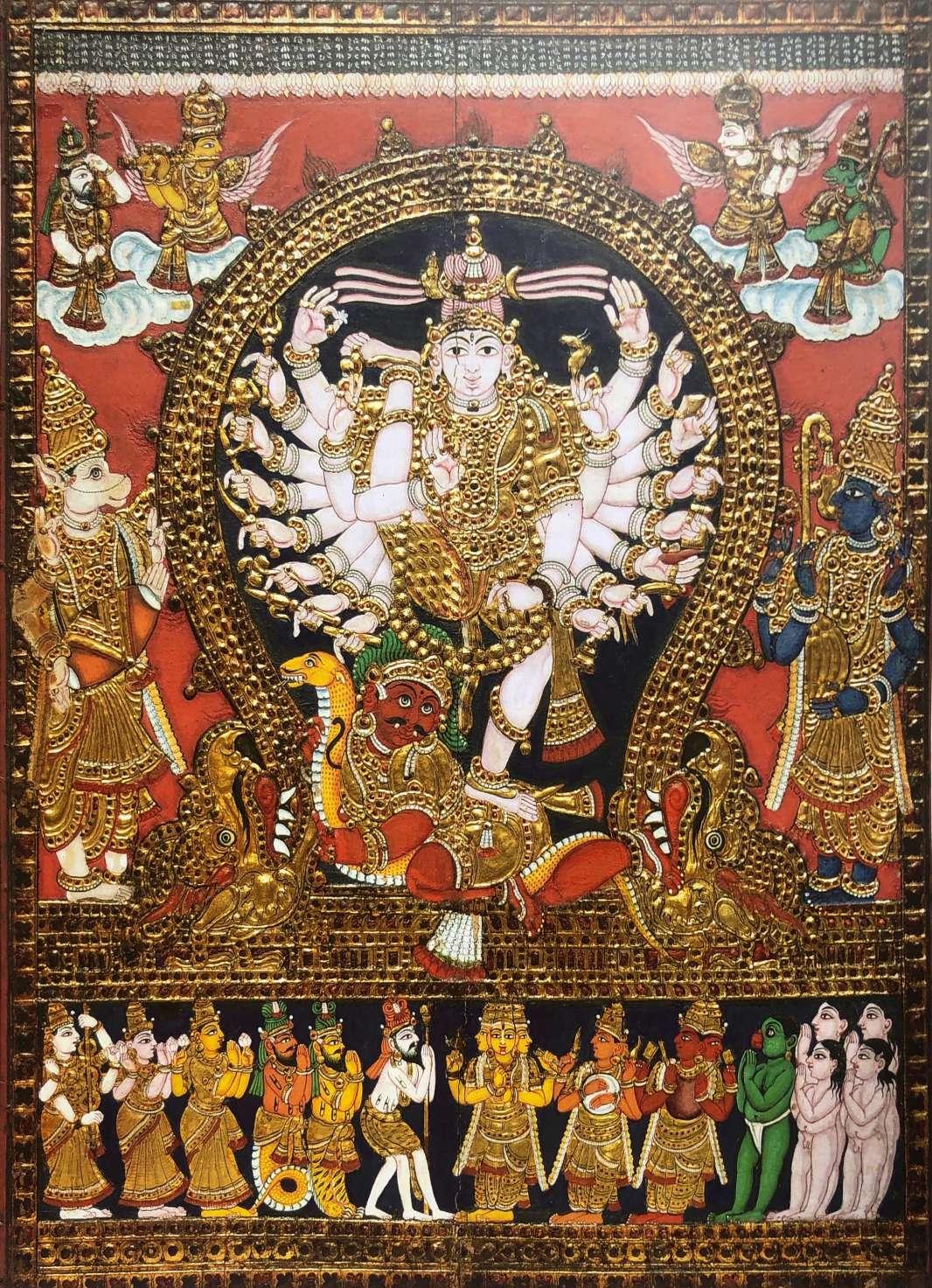
Following page Shiva as Urdha Tandava, Tanjavur, 75 x 57 cm
(Thanjavur’s Gilded Gods, 2018)
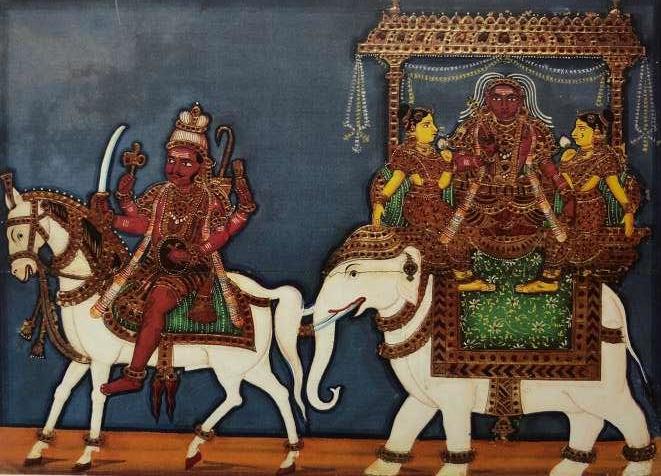
Aiyanar, his consorts and Karuppan, Tanjavur, 75 x 57 cm
(Thanjavur’s Gilded Gods, 2018)
While speaking to a hereditary artist I gathered that when families planned to construct a house, a Tanjavur artist was also consulted alongside consulting wood artisans and masons. The family discussed the theme of the painting and a token sum was given to the artist before the construction of the new property. The artist would bring a semi-finished painting to the house at an auspicious time. Prayers were rendered after which the artist would proceed to paint the eyes of the central deity as the final part in finishing the painting. The painting would then be ceremoniously hung in the family’s worship room.
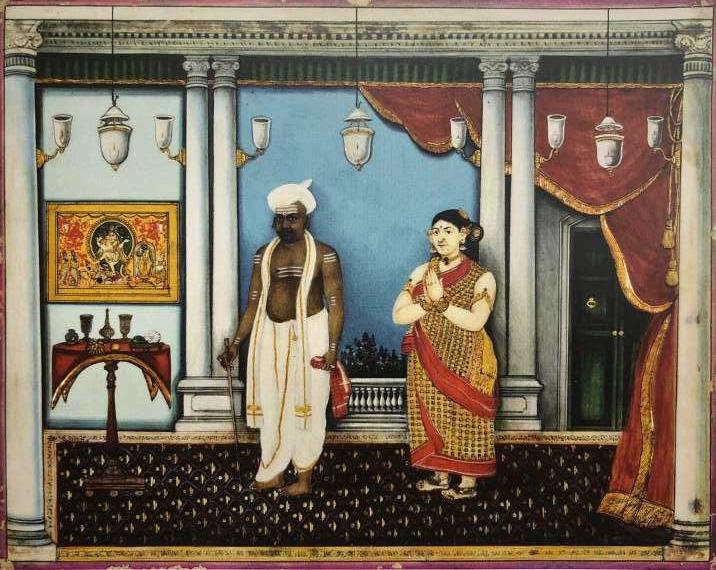
Accountant and his wife, Tanjavur, 38.1 x 49.9 cm
(Thanjavur’s Gilded Gods, 2018)
We know of Tanjavur paintings as depictions of the Gods but some rare ones that I have had the good fortune of seeing include those of devadasis, and lesser known folk stories. I have also seen a set of paintings depicting all the vahana processions of the Sri Ranganathar temple at Srirangam, and a beautiful set of Dasavataras.
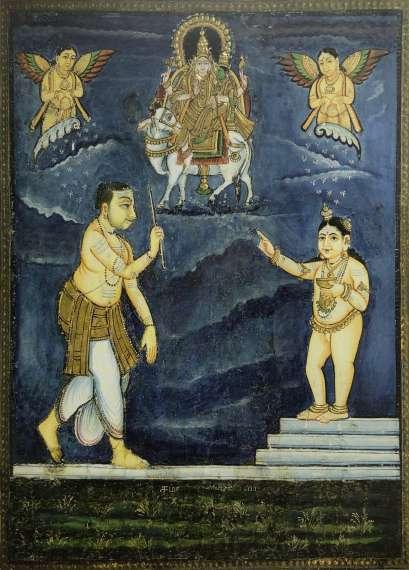
Top Left: Sambandar being scolded by his father, Tanjavur, 50 x 40 cm
(Thanjavur’s Gilded Gods, 2018)
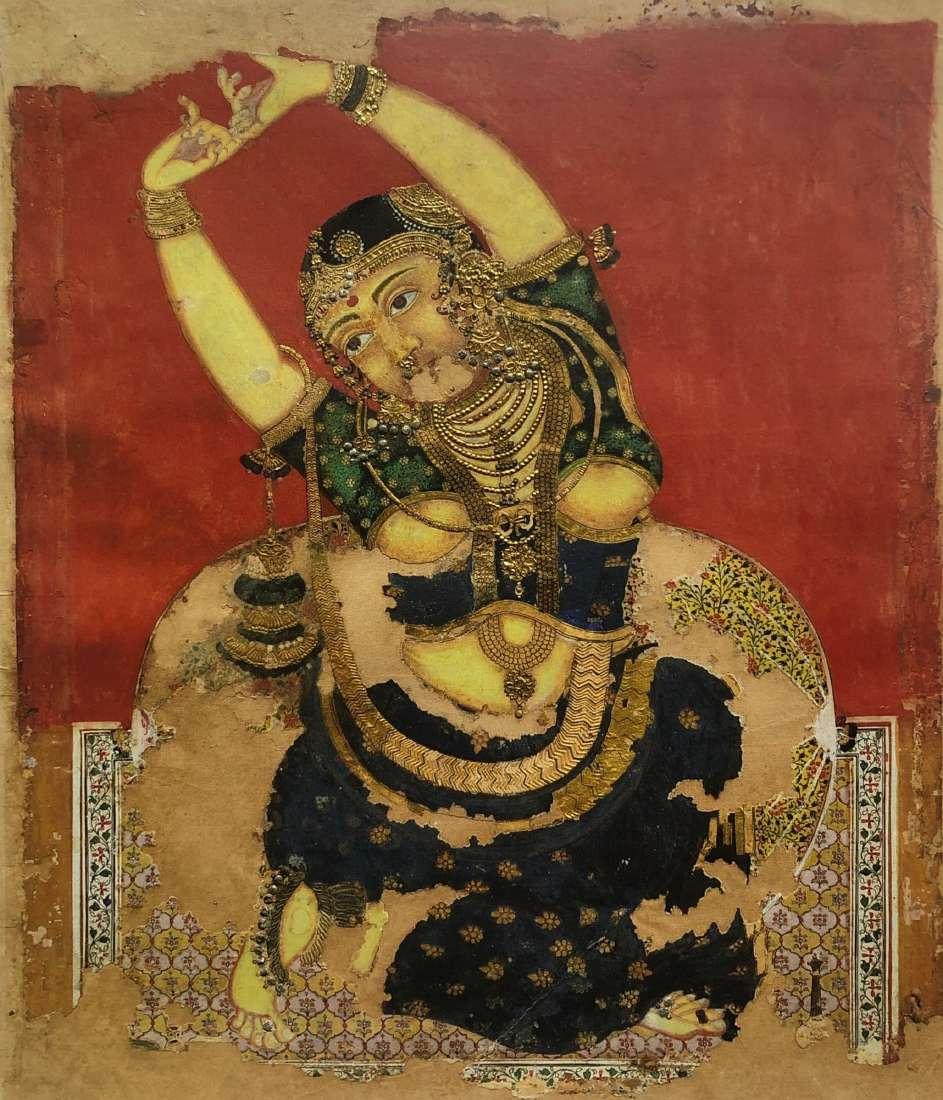
A lovelorn lady. Andhra (?). 63.3 x 51.4 cm
(Thanjavur’s Gilded Gods, 2018)
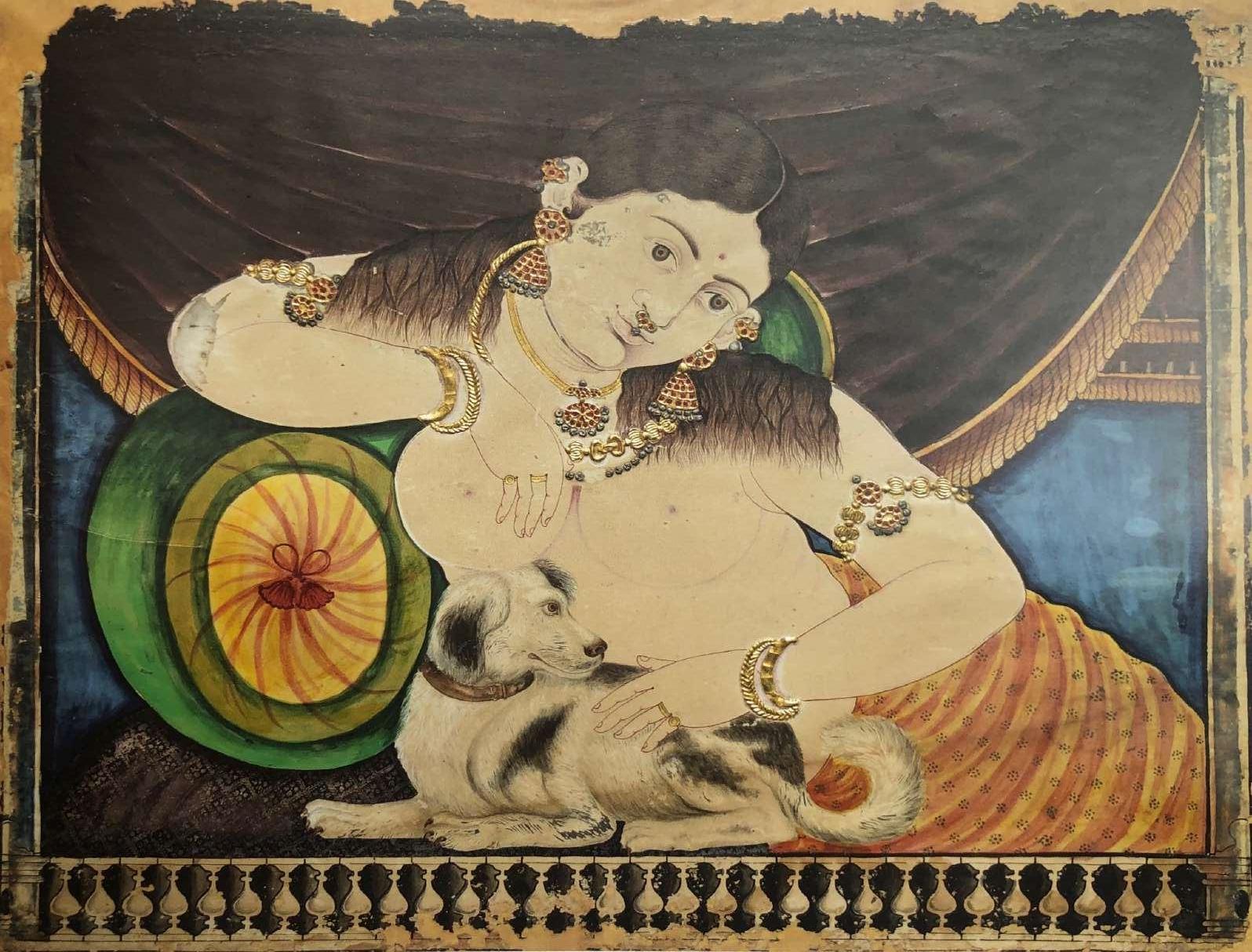
Portrait of a lady with a dog, 56.5 x 67.5 cm
(Thanjavur’s Gilded Gods, 2018)
Relevance in contemporary context
Although these paintings have become a household commodity, thanks to hobby artists and widespread interior bloggers, we should accept that the lovely delicate features became garish looking figures. The beautiful foil backed stones are now replaced by plastic, and the gold foil is a mere imitation of its original. Early Tanjavur paintings are typical of low relief gesso and exquisite attention to detail. In early period Tanjavurs, we can notice the adaptation of European looking interiors/blinds and Venetian chandeliers that are depicted hanging from the mandapam, floor chandeliers that are seen adorning the deity on either sides. But during the later period, especially post 1900s, these paintings came with lesser details and with heightened gesso. While the myth of precious stones like diamonds and emeralds inlaid into Tanjavur is very fascinating, it is often coloured glass with a foiled back that mimics precious stones. I am yet to see an example with precious stones inlaid into the painting.
Today the art of gilding with pure gold leaf is almost gone. It is very important to mention the ‘fake Tanjavur’ market that thrives on collectors’ love for older works. The skyrocketing prices in turn lead to great artists faking and remaking old looking paintings rather than them making contemporary new ones, adhering to the old examples and principles.
I truly wish the handful of artists who hold the skill of gilding teach it to their students. I also hope for contemporary artists to collaborate with each other to create master pieces that will help in the survival of this artform. There is an urgent need to revive the Tanjavur painting tradition. Private collectors and households need to come out with their collections to share and celebrate this
rich vibrant heritage, opening a dialogue for an in depth study of these bejewelled wonders.

Following page Muruga as Dhandapani, 38 x 30.5 cm
(Christies, 2016)
- Veeren is a radiologist by profession. He is a connoisseur of South Indian arts and is based out of Pondicherry.










